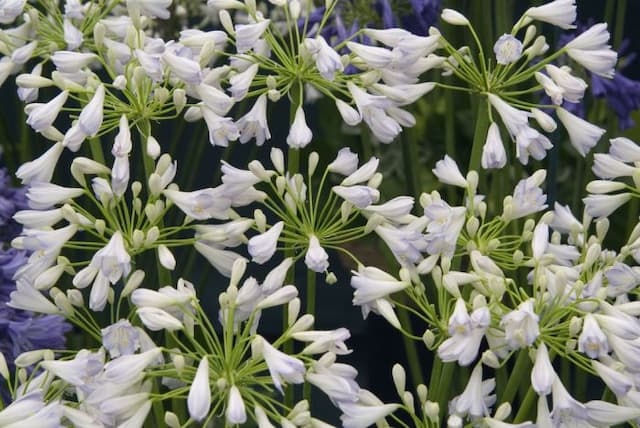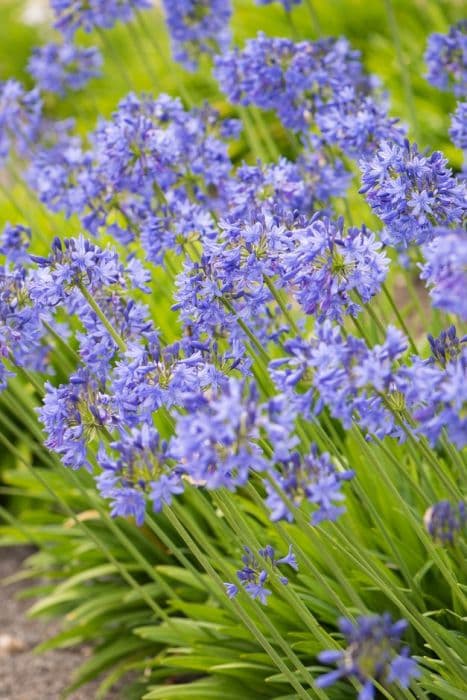African Lily Agapanthus 'Bressingham White'

ABOUT
Agapanthus 'Bressingham White' is a striking ornamental plant known for its elegant and sophisticated appearance. The most notable feature of this variety is its large, rounded clusters of trumpet-shaped flowers that are a pristine white in color, giving it a pure and fresh look. These flower clusters bloom at the end of long, sturdy stems that rise above the foliage, creating an impressive display. The foliage itself consists of lush, strap-like leaves that form a dense clump, with a bright green color that contrasts beautifully with the white blossoms. The leaves are narrow and arch outward from the base, adding to the plant's graceful profile. When in bloom, the plant becomes a focal point in any garden setting, attracting attention with its abundant flower heads and the bold yet simplistic color scheme.
About this plant
 Names
NamesFamily
Amaryllidaceae
Synonyms
African Lily, Lily of the Nile
Common names
Agapanthus 'Bressingham White'
 Toxicity
ToxicityTo humans
Lily of the Nile (Agapanthus 'Bressingham White') is considered mildly toxic if ingested. In humans, consumption of this plant can cause gastrointestinal issues such as nausea, vomiting, and diarrhea. It can also cause skin irritation upon contact with the sap.
To pets
Lily of the Nile is also toxic to pets, including cats and dogs. If ingested by pets, it can cause symptoms such as nausea, vomiting, and diarrhea. In some cases, more severe reactions like tremors or an irregular heartbeat could occur if large quantities are consumed. Owners should seek veterinary care if they suspect their pet has ingested this plant.
 Characteristics
CharacteristicsLife cycle
Perennials
Foliage type
Deciduous
Color of leaves
Green
Flower color
White
Height
2 feet [60 cm]
Spread
1.5 feet [45 cm]
Plant type
Bulb
Hardiness zones
8
Native area
South Africa
Benefits
 General Benefits
General Benefits- Attractive Flowers: Produces large clusters of white blooms on tall stems that add elegance to gardens and flower arrangements.
- Drought Tolerance: Once established, it can withstand periods of low water, making it suitable for xeriscaping.
- Long Blooming Season: Offers a long flowering period from late spring to early autumn, providing sustained visual interest.
- Low Maintenance: Requires minimal care once established, making it convenient for busy gardeners.
- Deer Resistance: Not typically favored by deer, which helps to prevent damage in areas with deer populations.
- Rabbit Resistance: Less likely to be eaten by rabbits, safeguarding the aesthetic appeal of the plant.
- Border Plants: Ideal for borders and edges in gardens due to its clumping growth habit and attractive foliage.
- Container Gardening: Suitable for pots and containers, allowing for flexibility in placement and design.
- Attracts Pollinators: Flowers attract bees and butterflies, which are beneficial for pollinating garden plants.
 Medical Properties
Medical PropertiesThis plant is not used for medical purposes.
 Air-purifying Qualities
Air-purifying QualitiesThis plant is not specifically known for air purifying qualities.
 Other Uses
Other Uses- Flower Arrangement: The long-lasting flowers of the Agapanthus 'Bressingham White' make it an ideal choice for fresh floral arrangements and bridal bouquets due to its elegant white blooms.
- Photography Prop: Because of their striking appearance, these plants can be used as a photogenic backdrop or focal point in garden photography.
- Educational Tool: Agapanthus can be used in educational settings to teach about plant reproduction, as they have distinct flower structures that are easy to identify and study.
- Dye Source: The sap and petals of Agapanthus could potentially be used to create natural dyes for fabrics or artwork, although it's not a common application.
- Ink Ingredient: Similarly, the pigments from Agapanthus flowers might be used to create botanical inks for art or calligraphy.
- Erosion Control: Agapanthus, with its thick root system, can be planted to help stabilize soil in areas prone to erosion, though this is more typical with species known for dense foliage.
- Garden Theme Creation: Agapanthus 'Bressingham White' can be used to create garden themes, such as 'moon gardens' with white-flowering and silver-foliaged plants that glow at dusk.
- Landscape Patterning: These plants can be strategically placed to create patterns and borders in landscape design, taking advantage of their clumping growth habit.
- Water Feature Enhancement: The serene white of Agapanthus 'Bressingham White' can complement ponds or fountains, providing a visual contrast to the blue water.
- Culinary Garnish: Although not widely recognized as edible, the blooms could be used as a decorative, non-toxic garnish for special dishes in high-end culinary presentations.
Interesting Facts
 Feng Shui
Feng ShuiThe African Lily is not used in Feng Shui practice.
 Zodiac Sign Compitability
Zodiac Sign CompitabilityThe African Lily is not used in astrology practice.
 Plant Symbolism
Plant Symbolism- Love Letters: Agapanthus, also known as African Lily, often symbolizes love letters. This association comes from the flower's shape that resembles the envelope of a letter, signifying an exchange of emotions and thoughts.
- Enduring Love: The African Lily also represents enduring love. This is attributed to its sturdy and resilient nature, reflecting the strength and endurance required in lasting love.
- Beauty: With its striking white blooms, the 'Bressingham White' variety of Agapanthus is often linked with purity and beauty—appreciated for its elegant form and pristine coloration.
- Fertility: In some cultures, the lush and full blossoms of the Agapanthus can be associated with fertility and abundance, symbolizing the creation and nurturing of new life.
- Friendship: Given as a gift, this flower can symbolize a message of friendship and trust, its perennial nature reflecting the long-term, consistent nature of a solid friendship.
 Water
WaterAfrican Lily should be watered deeply once a week during the active growing season, ensuring the soil is moist but not waterlogged. During the winter months when the plant is dormant, reduce watering to every two to three weeks, giving about half a gallon per plant to keep the soil from drying out completely. Always water at the base of the plant to avoid wetting the foliage, which can lead to fungal diseases. It’s important not to let the plant sit in water, as this can cause root rot.
 Light
LightAfrican Lily thrives in full sun to partial shade conditions. It prefers a spot that receives at least six hours of direct sunlight a day but can tolerate some afternoon shade. The bright light encourages abundant blooms, so place your African Lily in the sunniest spot available for the best flowering results.
 Temperature
TemperatureAfrican Lily does well in a wide range of temperatures, but it is best to keep it in conditions between 50 and 80 degrees Fahrenheit. It can survive brief dips down to 20 degrees Fahrenheit, but prolonged exposure to temperatures below freezing can damage the plant. Ideally, maintain a temperate environment that avoids any frost for optimal growth.
 Pruning
PruningPrune African Lily after flowering has finished to tidy up the plant and encourage further blooms. Remove spent flower stalks by cutting them at the base and trim any damaged or dead foliage. Pruning is typically done annually, in late summer or early fall, after the main blooming period has passed. This helps to maintain the plant's shape and vigor for the following season.
 Cleaning
CleaningAs needed
 Soil
SoilAfrican Lily 'Bressingham White' thrives in rich, well-draining soil with a pH range of 6.0 to 8.0. A mix of garden soil, compost, and perlite or sand to enhance drainage is ideal. Regular feeding with a balanced fertilizer will support robust growth and flowering.
 Repotting
RepottingAfrican Lily 'Bressingham White' does not require frequent repotting and can be done every 2 to 3 years. They prefer to be slightly root-bound, which often promotes better blooming.
 Humidity & Misting
Humidity & MistingAfrican Lily 'Bressingham White' thrives with average to slightly above average humidity levels. They can tolerate some dry air but prefer consistent humidity without being overly damp.
 Suitable locations
Suitable locationsIndoor
Place in bright light and water moderately.
Outdoor
Plant in sun; well-draining soil; water regularly.
Hardiness zone
7-10 USDA
 Life cycle
Life cycleThe life cycle of the Agapanthus 'Bressingham White', commonly known as African Lily, begins with seed germination, where the seed must be sown in a well-draining medium and kept moist until germination occurs. It progresses to the vegetative stage, where foliage growth is prioritized, and the plant develops long, strappy green leaves. As it matures, the African Lily enters the flowering stage, typically in summer, producing tall stalks topped with white, trumpet-shaped flowers clustered in umbels. After pollination, seeds develop within the capsule-like fruits, completing the reproductive stage. Eventually, the plant reaches dormancy during colder months, where growth slows down or ceases and the above-ground parts may die back, awaiting the return of favorable conditions for the next growing season. The African Lily can also propagate vegetatively by division of its root clump, enabling mature plants to produce genetically identical offspring.
 Propogation
PropogationPropogation time
Spring-Early Summer
The most popular method to propagate Agapanthus 'Bressingham White', commonly known as the African Lily, is through division. This is typically done in the spring before the plant begins its active growing phase. To propagate by division, carefully lift the plant from the ground using a garden fork, then gently separate the clumps of bulbs by hand or with a knife. Each section should have at least one growing point or shoot. Replant the divisions immediately, about an inch (2.54 cm) below the soil surface, spacing them about 12 to 18 inches (30 to 45 cm) apart to allow for adequate growth. Water the new plantings thoroughly to help establish them. Division can encourage more vigorous growth and is an easy way to increase your stock of Agapanthus 'Bressingham White'.









